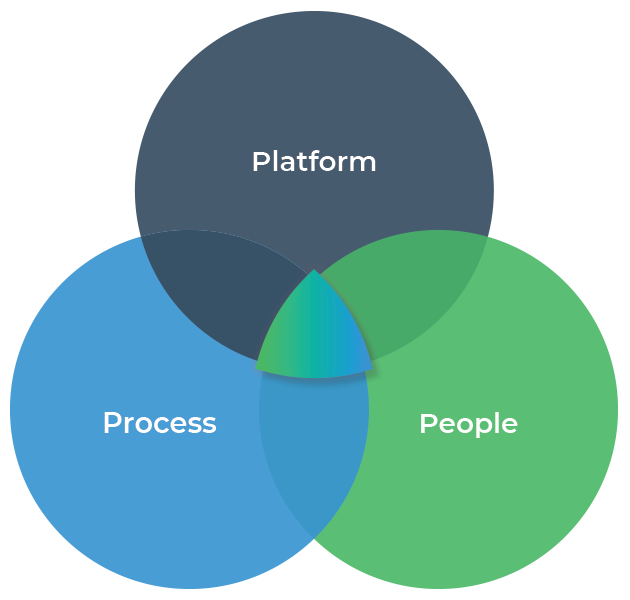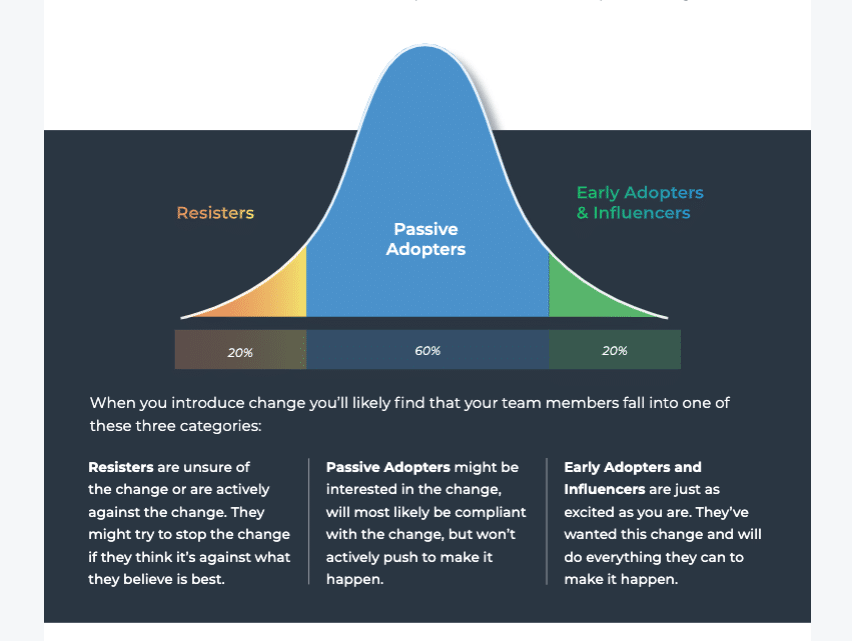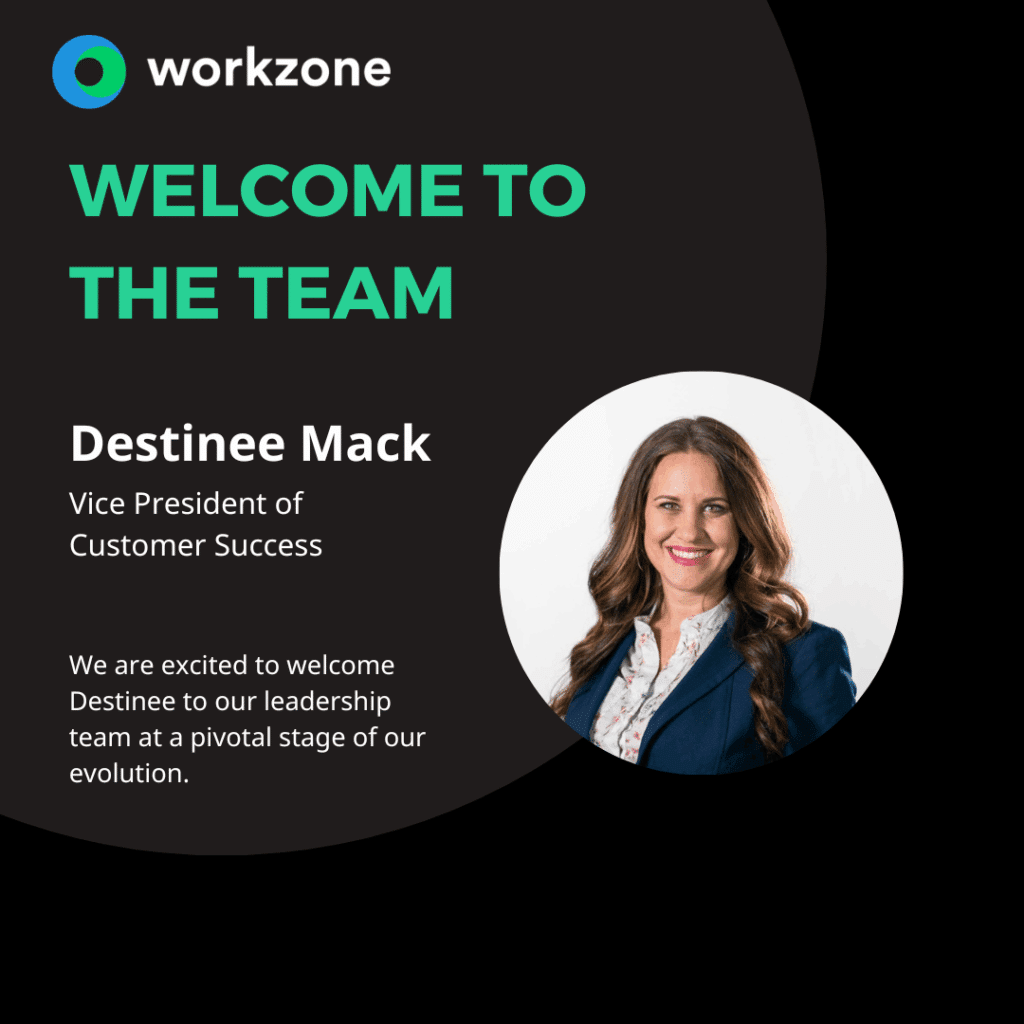Choosing Project Management Software: The Complete Buyer’s Guide

Choosing project management software has become a monumental project by itself. The number of project management software solutions available has exploded in recent years. Last we checked, consumers had over 1,000 tools to research and this trend is set to continue. The market is expected to grow by over 10% per year, on average, for at least the next five years.
It’s no surprise that the project management space has grown so rapidly:
- More teams are working remotely with fewer resources
- Technology is expanding rapidly
- Project management software can do more and more to help teams stay connected and be more productive
Finding a project management software isn’t hard. Finding the right solution to meet your needs and be adopted by your team is the hard part.
Too often, the search is focused just on features and fancy interfaces. This step-by-step guide will walk you through much more, focusing your search around what we call the three Ps:
More than just software
This guide will walk you through the research and selection process. Throughout the way, we highlight three areas of success when choosing project management software: the “Three Ps”.

- Platform: You can’t escape this step! You’ll need to identify what level of features you need. Today’s project management offerings start at basic task management up to fully-featured enterprise software.
- Process: Process is where features meet the unique needs of your team. The intersection of a team’s unique needs and the processes you want is the cornerstone of successful project management. How much customization do you need? Does the software you’re using meet your unique processes?
- People: Adopting any software can be a challenge. Some project management software solutions expect your team to use them right out of the box with very little support. Other solutions offer onboarding programs and training to help your team get up to speed.
Understanding Your Team’s Needs
At one end of the spectrum are the project management solutions offering simple, easy-to-navigate task management. At the other end is software boasting an end-to-end business solution.
Your primary goal is to match your current workflow and plans to scale, with a tool’s primary function.
Step 1: Assess your team’s current state
- Did a recent project fail due to a lack of order and efficiency?
- Can I pull up a dashboard and see the status of my projects?
- How often are we late on our deliverables?
- What would our internal and external clients say about the quality and timeliness of our work?
- Day to day, do I know what my team is working on?
- Do I have data to identify if my team over or under-worked?
- Are our meetings just general status meetings when you need to dive in on strategy or talk about roadblocks?
- Is my team using too many tools (excel, task lists, email, etc.) to track different aspects of our projects?
- Have our business and organizational needs outgrown the capacity of our current PM process or tools?
- With our current project management tool, are the issues not adequately tracked and risks not flagged in time?
- Is our software complex? Is our software so complex that it’s creating inefficiencies? For example, does it take too long time for new hires to get up to speed at the sacrifice of increasing productivity earlier on?
- Does our current tool cause the collaboration among team members not to be efficient or effective?
Step 2: Clarify why you need a solution
You are reading this guide, so that’s an admission that you know you need a better way to manage projects. But just because you know you need a solution doesn’t mean that others will get on board. So it’s imperative that from a 10,000 ft view, you identify why you need a new PM solution?
To spur your imagination, here are common scenarios we’ve heard from customers who knew it was time to invest in new project management software:
- Save time: Your team is spending too much time on emails and meetings and not enough time on creating deliverables.
- Focus your team: Too often you feel your team is not working on the highest priority projects.
- Create streamlined processes: Your team uses too many tools, excel, email, other PM tools. There isn’t a consistent way your team is working, and it’s causing inefficiencies.
- Better visibility into what the team is doing: You’re not entirely sure what your team is working on. You can’t pinpoint where projects are falling behind or spot bottlenecks.
- More functionality: You need more out of your current PM solution. It may be missing helpful tools, or your workload is too large for its capacity.
- Easier to Use: Your current tool is too complicated. You’re spending too much time training everyone on how to use the software.
Step 3: Get your team’s feedback
Now that you’ve identified why you need a solution, it’s time to bring your team in on the discussion. This is a huge factor in achieving long-term success with a project management tool. Your team will feel empowered by being included in the decision-making process, increasing the feeling of ownership. Imagine what this does to adoption and buy-in once the tool is implemented!
It can be challenging for team members to articulate what they need from a project management tool. They may not understand all the features available, or what the features can do for them. Your leadership will help immensely here. Sit down with your team and map out current workflows. This team activity will root out where the inefficiencies and themes of needs lie.
“People who are closest to the problem, are closest to the solution.” – Kerry Kennedy, the President of the Robert F. Kennedy Center for Justice and Human Rights
While this process helps your team, it’s also vital for you to hear your team’s feedback – good or bad. You may feel the urge to jump in and share what you’ve uncovered in steps 1 and 2; instead, lead them to the answers.
Brainstorming exercise with your team
- How often do you feel unsure of what your priorities are day-to-day? This question will bring into focus where your team is spending their time.
- On a scale of 1 to 10, are you feeling stressed about our work? This will help you gauge overall stress levels and help you know if your team feels burnt out.
- Where do you see inefficiencies in –INSERT IMPORTANT PROCESS HERE–? This will tell you what processes they think need improvement.
- Tell me about a time you wished I was more in the loop so I could be more helpful. This will let you in on what you might be missing.
- What process could we have put in place to overcome –INSERT PAST ISSUE HERE__? This will help your team identify new processes that could help your team overcome inefficiencies.
- If we started looking for a new project management software, what would be the benefits? What are your concerns? This will help you identify any resistance your team has to change so you can address it in your plan.
Step 4: Reflect on your team’s feedback and how they work
Teams are made up of different skill sets and work habits. As a result, teams need project management tools with varied feature sets. Other impactful characteristics of project management software are the size of your team/company, the nature of your business, and your projects’ complexity.
Some teams only need a simple tool to help keep track of specific tasks or to-do lists. Others could benefit from additional features such as task assignment, progress tracking, and reporting. Companies that require project management of professional and business-critical activities will need broader functionalities, including resource allocation, budget planning, and invoicing.
Consider how your team handles change and adopts new tools to identify the level of support you’ll need:
- How successful have you been at adopting other software solutions without training & support?
- Do you expect your team to push back or be excited about this change?
- Does your team typically need training and support?
- Do you plan to have a subject matter expert (SME) on the team?
- Do you need a tool with advanced or custom features?
The physical location of your team can also impact your choices. Do you have a lot of remote workers or teammates located in separate buildings? If so, collaboration and communication are likely higher on the list of project management tool provisions than if your team is together in an open floor plan office space.
Step 5: Outline what tasks and processes need to be covered
Utilizing your initial review and your team’s feedback, think through a typical work week or month and note the project management-based tasks you encounter.
As you do this, remember to be intentional when defining your needs based on your current processes. Ask whether you’re following steps because they are necessary or if you’re following them simply because “that’s how it’s always been done.”
Once you have a list of frequent tasks, some questions to ask include:
- What do these tasks involve?
- What do you have to do to get them done?
- Is the current process ideal, or do you wish you had tools to help you get them done more efficiently?
- How can you make the current procedures repeatable?
Two other key questions to consider:
- What is the projected growth of your company?
- What kind of project management needs do you anticipate in the next few years?
Step 6: Narrow down your requirements
After you’ve answered all of the questions we’ve just covered, you may have a very lengthy list of requirements for your new project management software.
To help narrow down your options and avoid complicating the process, zero in on your top three feature needs.
Start by defining your team’s needs and challenges, and then prioritize those most critical. This process will help you select the project management software that will be most relevant to your team and your company.
Identifying the level of tool you need
As of April 5, 2022, Software Advice shows 1,380 project management software solutions on the market. That’s an overwhelming number of options to sift through!
We find the easiest way to start narrowing it down is by grouping solutions into tiers. These groupings provide an easy way to visualize the market. The majority of solutions can be classified into three tiers: Task Management Solutions, Balanced Solutions, or Enterprise Solutions.
Tier 1: Task Management Solutions
These products tend to be very user-friendly but also light on features. They’re among the most readily available tools because most offer freemium pricing models. What Tier 1 solutions sacrifice in functionality they gain in ease of use.
Common characteristics of Tier 1 solutions:
- Solves the needs of an individual or small team
- Simple to use
- Typically focus on design and aesthetics
- Reporting and other features often leave much to be desired
- They tend to lack all-projects or inter-departmental views
This software tier may be perfect for smaller teams (up to 15 users) who handle simple projects. Pricing ranges from free to $10/user. As your work grows in complexity or scope, you may find you need something more.
Tier 2: Balanced Solutions
These products offer a balance of usability and features. While most solutions offering similar starting prices, pricing varies based on increased features, integrations, and the level of support provided.
Common characteristics of Tier 2 solutions:
- Solves the needs of teams or departments managing numerous projects
- Designed with a short-to-medium learning curve for most users
- More focus is on functionality rather than design and aesthetics
- Some customization available
- Project oversight provided by an all-projects view or dashboard
- Personal to-do lists can be utilized to keep individual contributors on track
- Often includes more comprehensive views such as Gantt Charts
- Collaboration features allow clients to request projects and communicate within the system
- More robust reporting features available to help you track progress and export executive reports
- Advanced PM functionality may be available to keep projects on track, such as dependencies, lead and lag, and milestones
- Add-ons provide access to other tools within or outside the software such as image mark-up, time tracking, expense tracking, and API integrations
- While you don’t need to be a PM professional to manage these systems, you will likely need support and training
This tier of project management software works well for teams of 5-25 people or more. The key is understanding how the tool fits your short and long-term goals.
Pricing typically ranges between $20-$40/user per month with additional options for onboarding, training, and support.
Workzone is a Tier 2, “Balanced Solution”
Perfected through 20+ years of real-world use, with the power and usability to manage busy workloads. Backed by a proven adoption process and continuing with unlimited training and quarterly success calls – Workzone’s support stands out from any other tool of this caliber on the market.
Tier 3: Enterprise Solutions
The project management software in this tier offers the most functionality. The amount of features adds complexity. With complexity comes increased learning curves. Increased learning curves makes it more difficult for user adoption.
Common characteristics of Tier 3 solutions:
- Solves the needs of 3+ departments or the entire organization
- A higher learning curve with customized features
- Implementation typically requires onsite onboarding and setup
- Focus is more on functionality over design and aesthetics
- These solutions typically scale up all the features from Tiers 1 and 2 and add more
- Higher levels of admin permissions are available, usually managed by IT
The Enterprise Solutions tier is ideal for a large company or department. Teams looking for this type of solution often have formal project managers and a PMO (project management office.).
Pricing is mostly via annual contract instead of user-based. Pricing of at least $20,000/year is not uncommon, with contracts including a mandatory implementation package.
Creating a shortlist of software solutions based on your tier
You’ve identified whether you need a task-based, balanced, or enterprise project management software solution. Now you need to identify a shortlist of solutions that meet those needs.
Selecting the tier of software that best suits your needs will help guide you to the best choice for your teams and organization.
The latest from Gartner’s Software Advice in the online project management category

Here are some resources that can help you narrow down your choices:
Capterra’s top ratings for Project Management Solutions
Software Advice’s Comparison Tool for Project Management
G2 Crowd’s Project Management Grid
Understanding the features available
With the current volume of project management software options, reviewing feature lists can be daunting without a foundation in what each feature is and what it is meant to accomplish.
Take a few minutes to familiarize yourself with the various functionalities and what they do. You won’t feel overwhelmed when you start your review of project management products.
Many project management solutions have similar features but approach them in different ways. Think about how this will impact your team dynamic when determining the features you want in a tool.
Features available in various project management solutions
- Project Dashboards
- Task Management
- Scheduling and Planning
- Communication
- Project Requests & Approvals
- Customer Support
- Document Management
- Image Mark-up
- File Versioning
- Task Dependencies
- Customization
- Reporting
- Time, Budget, & Resource Management
- API & Integrations
- Onboarding & Success
1. Project Dashboards
Getting a high-level view of project statuses with a team dashboard helps keep everyone updated on the project status.
Key project dashboard features to look for:
- One view to see all projects at once. Seeing all projects at once allows managers to get a bird’s eye view of active projects.
- Status alert icons stand out because a manager can then quickly see if a project is at risk or late.
- Completion percentage charts allow a manager to see how far a project has been completed.
This high-level dashboard also communicates the project status to stakeholders and sponsors who may not need to see the details presented in a written report.
2. Task Management
Projects are collections of tasks, so the management of these tasks becomes vital to the project’s success.
Here are some key task management features:
- The ability to assign and re-assign tasks to your team members, so everyone knows what needs to get done and by whom.
- The ability to sort tasks in different ways – by completion date, priority, resource, department, etc., so information can be located and organized quickly.
- Individual team member views and daily notifications to keep everyone on track.
Bonus task management feature: Task Dependencies – Notify the next responsible team member when their task can start.
3. Scheduling and Planning
You may be able to manage a small project with a spreadsheet listing tasks, but that can get out of hand in a hurry, right?
When evaluating Scheduling and Planning features, look for ways to visualize your timelines:
- Date-based Project Dashboard
- Gantt Charts
- Calendar
- Resource Management reports
- Critical Path lines
“A good plan today is better than a perfect plan tomorrow” ~ Proverb
4. Communication
Excellent communication is key to facilitating collaboration and ensuring tasks get done efficiently. In a new remote working world with distributed teams across the world, the need for streamlined yet clear communication is increasingly critical.
Key communication features:
- Built-in messaging with @ mentions. Mentions allow teams working asynchronously to communicate with each other within a tool rather than sifting through piles of emails.
- Comment threads attached to projects, files, and tasks so that comments are always read within the right context
5. Project Requests & Approvals Management
If you’re working with internal or external clients, you’ll need to have a centralized location and process to manage project requests.
What you’ll want to keep in mind while looking for a tool that effectively manages project requests:
- Project request forms can be customized based on the type of request coming into your team
- Form functionality that prevents requesters from submitting last-minute requests
- A project request dashboard that allows you to manage project requests and approvals
- Collaboration and notifications for requesters
- Integrated image mark-up tools and document versioning to track progress
- Tracking that links project requests to a report to see who is requesting what projects and the status of those projects
6. Customer Support
Which level of support you need will likely depend on the complexity of the tool you choose, your users’ expertise, and whether or not you plan on having subject matter experts in-house.
Task management solutions often come with very little or no support.
Balanced and enterprise solutions often require more training and support; however, not all are created equal.
What you should look for when evaluating customer support:
- Most systems will offer a knowledge base to search and find answers
- Fast response times from a team that natively speaks your language
- Dedicated training hours included with your onboarding program
- Additional training available if your team grows or your needs change
Five Star Customer Support
“It’s strange to love a software because of the customer service, but Workzone’s responsive, witty team made deploying this robust program with 30+ reluctant creatives successful.”
Keri, Mississippi State University
7. Document Management
Most project management software gives the capability to share files internally with team members, providing quick access to the information they need to complete their work.
If your team often works with people outside your company, such as vendors, contractors, or clients, you will also want to have the ability to share files with these external parties within your project management tool.
Bonus Document Management Feature:
Advanced Security
Depending on your industry and market, you may have sensitive project data that requires a higher level of security and access control. Look for a tool that can restrict access to certain documents.
8. Image Mark-up
Image mark-up tools allow you to add markup comments directly on a PDF or image, helping save time and improve collaboration in your creative review process.
An image mark-up tool is an excellent substitute for making physical notes on a printed document or using third-party tools, like Adobe Acrobat. You’ll be able to centralize creative collaboration efforts all in one system by storing all comments and revisions.
In addition, all communication should be attached to the project at hand, so you no longer need to hunt down email communication to identify why copy or colors were changed.
9. File Versioning
File versioning enables you to easily keep track of multiple versions of files as they are revised. If your team tends to share and collaborate on a lot of files, you may need a tool that will automatically track which one is the latest version.
This feature helps you maintain a record of all versions of a particular file to eliminate confusion and ensure that your team is using the newest version.
10. Task Dependencies
Task Dependencies are the rules between tasks that tell if a task can be started or not based on the completion of another. In layman’s terms, Task B cannot start until Task A is completed.
You usually can find dependencies in most balanced and enterprise-level systems.
Task Dependencies are important because most projects have a sequential step-by-step plan until completion. These rules allow for order within a project and set clear expectations on how long tasks take and who is responsible for doing them. If the date for a task moves, the dates for all tasks dependent on it will be shifted accordingly.
This helps project managers ensure projects follow the correct order. Because of these logical steps, managers are able to use workload reports to plan out their team’s projects in advance.
BONUS DEPENDENCY FEATURE:
Lead and Lag
Sometimes, the next task doesn’t start immediately after the previous task has finished. For example, the final 2 tasks in a print project are to send the design to print and to deliver the final version to the client. If printing typically takes 3 business days, then we will add that 3 days as lag time to ensure we give ample time to meet the delivery date.
11. Customization
While most systems will offer some sort of customization, the level of customization can range from custom branding to more impactful changes that make your processes more efficient.
Customizations to look for:
- Branding: Custom branding helps you create a “work environment” that reflects your brand or your clients’ brand – from logo to color scheme to custom exports and how you prefer data to be organized.
- Data columns: The ability to edit the data columns within dashboards or reports. Selectively display information so you can easily and quickly show the data and metrics relevant to each stakeholder audience.
- Project Templates: Every team has repeatable, predictable projects that follow the same or similar steps each time. An intuitive project management feature will allow you to save these projects as templates so you can load them in seconds.
- Project Request Forms: Custom forms allow you to capture custom information from requesters. See more about requests management.
12. Real-Time Reporting
Reporting tools collect your previously inserted project data and create reports around critical metrics such as project budgets, expenses, resource allocation, team member performance, and more.
Most project management tools have a predefined set of reports you can generate, with some also supporting customized reporting.
If your company requires reports in a particular format or laid out in a specific way, make sure the tool you select can accommodate these needs.
13. Time, Budget, & Resource Management
Time, Budget, & Resource Management often overlap. When they’re centralized in one project management software, they can often inform each other and help allocate your resources more efficiently.
Time Tracking
Time tracking gives managers visibility into the time each project takes and each team member’s workload to identify which tasks monopolize the most time, resources, and budget — and to make changes accordingly.
It is particularly useful in scenarios where you need to keep track of the time worked on specific tasks for client billing or project costing.
Resource Management
Resource management covers more than managing team members’ time and availability. A project management tool can outline all the scheduled and planned resources to help you calculate the cost of their usage and make sure everyone has what he or she needs to complete a task. You can also allocate resources such as meeting venues or materials used in a project.
Some project management software can also calculate the planned hours of work across projects by person or resource type by period, so that you can quickly identify resources that are over or under-allocated.
Budget Management
Many features can help you stay on budget and save time on hours tracking and billing tasks.
A project management tool with integrated budget reporting, time tracking, time billing, and invoicing will allow you to create budget reports that reflect the real-time status and resource usage of your projects.
If you already have in-house budgeting and/or financial software, make sure your project management tool can integrate with it so that hours and costs can easily be shared back and forth and reports are always in sync.
14. API Integration
Do you want to keep the cloud-based apps and tools your team is already using for file sharing, messaging, scheduling, and the like?
If so, look for project management software with a robust API so you can seamlessly connect to the apps and tools that your team loves.
15. Onboarding programs
Picking the right software isn’t enough. To implement a new project management software you’ll need to get your team’s buy-in, map out processes, and provide training.
This is especially important if you’re looking for more than a task-management system.
You’ll want to look for:
- An onboarding process that’s comprehensive and involves more than just training; including:
- An assessment of your current processes
- A dedicated customer success manager that will help you overcome obstacles
- Unlimited training available for your team now and in the future as your needs change or new employees join your team
- Additional success coaching after your onboarding program is complete
Overall, you’ll want to look for a partner that will help your team build the foundation, processes, and discipline you need to drive your project management success.
World Class Service
“Our account manager has been one of the reasons we have been with Workzone for so long–his service is bar none.”
Sarah, Governors State University
Choosing the features you need
After working through the section in this guide on defining your team’s needs, you should have a list of the top three requirements your project management software must meet. And now that you have an overview of the various features offered by the project management tools on the market, you can start matching these features with your needs.
If one of your biggest challenges is communication, then features such as built-in messaging, real-time reporting, and project dashboards will likely be at the top of your list of requirements.
On the other hand, if your current software is so complicated and painful that no one is willing to use it, your top features might be ease of use, a solid user interface, and unlimited support.
Consider your unique circumstances to make sure the project management software you select meets the needs of your team, the nature of your projects, and the structure of your company – taking into account current requirements and future growth needs.
Work with your team to develop a list of the main features you want — make sure they solve your top three requirements.
Evaluating Software Solutions
Now that you’ve narrowed down the features you need, your first instinct might be to sign up for a free trial with each of the vendors you are considering. After all, they are offering it, so it shouldn’t be too difficult to try each one and make a final decision on your own, without the input of a salesperson.
But is a free trial really the best choice?
Should you sign up for free trials?
Most tier 1 task management solutions will only offer a free trial. This is because the tools tend to be more simplistic and straightforward.
Once you get to a balanced or enterprise-level tool it’s important to ask yourself if a free trial will really serve you. “If it’s free, it’s for me!” is not a universal truth.
Why Self-Service Free Trials Do Not Help in Purchasing Software
Wasted time
Self-serve trials exist because companies are hopeful that once you try it, you’ll buy it – without them needing to invest any time or energy. But with most tools, you’ll inevitably get frustrated attempting to decode their software.
Out of sight, out of mind
How many times have you signed up for a free trial of an app or online tool and *poof* the free trial period ends before you have the time to use it? Even with the best of intentions, we know it’s easy for the day-to-day to take priority.
Not enough access to make a decision
Most project management software free trials limit usage to basic use. In order to make a fully informed decision, you need to know that the software will work for you at every level.
Created for general, not custom, solutions
A free self-serve trial is fine when you need a general solution to a relatively simple need. But when you know ahead of time that you’ll need customization, it makes sense to connect with a sales representative.
You need more than just software
When in the market for project management software, what you’re really seeking is a project management solution from a vendor partner. You need software that provides the elements you need to work effectively and you need it from a company that is invested in your success.
An Alternative to Self-Serve Trials
As consumers we’ve been conditioned to the self-serve trial mindset, that’s why this usual course of action feels second nature.
How to make the best-informed choice for your project management software needs
Treat it like a job candidate search
Not to equate software with a person, of course, but you will rely on your project management software as a key component of your team. So instead of signing up for several self-serve trials at one time, choose one or two software solutions that appear promising and request an in-depth demo.
It’s like inviting the strongest candidates for a second interview. Having one-on-one guidance will avoid getting lost in features you don’t need and ensure you learn about the features most helpful to you.
Stay on Track
Your project management software search is a project on its own. Develop a timeline and communicate it to both your internal team and your salesperson to stay on track, find a solution, and get it up and running quickly.
Sometimes we need someone to help push us along, and if you’re working with the right company, they will help guide you through a clear process to meet your deadline.
Make sure your needs are understood
Every team is unique. When evaluating software solutions and working with a sales representative, they should understand why you’re looking for software, what your processes and goals are, and the pain points you have in your current workflow.
With this information, they should be able to identify what features and functionality matter most to you and discuss potential barriers to product adoption.
A customized demo
Which demo do you prefer?
- A boring same old sales pitch and walkthrough
or
- A personalized experience that showcases the features your team needs
This is why you need to make sure your needs are understood. You don’t want to waste time looking at a robust platform with dozens of features, instead, you want a custom demo configured to your team’s needs.
This first-hand, guided immersion is the ideal way to understand whether or not it’s the right product for you.
Getting your team on board
One of the main reasons process change fails is that users don’t like or cannot use the product.
As Everett Rogers said, “Getting a new idea adopted, even when it has obvious advantages, is very difficult.“
Unfortunately, project software adoption remains low, with only 22% of organizations using project management software. Yet statistics show that 77% of high-performing projects do use project management software to help manage their projects to success.
In other words, your new software can provide significant benefits but only if you do the work to ensure successful adoption.
1. Include your team from the start
If you have involved your team in the project management software selection process, they will already feel invested in the process and implementation and transition should be a smooth process overall.
However, some work may still need to be done to be certain everyone in your team understands the reason for the transition to new project management software and are fully on board with adopting this new process.

It’s important to share with your team how a new project management tool can help them become more efficient and productive. Focus on how the software will benefit them:
- Teams can spend less time in meetings and more time creating deliverables.
- Real-time project status tracking means less interruption from managers seeking status reports.
- A cloud-based application means team members can enjoy the flexibility of working from anywhere, at any time of day, as long as they have an Internet connection.
- A centralized place for document archives, commenting, and approval means better collaboration and less confusion – no more working off the wrong version.
- The use of better planning and resource assignment tools means clear accountability that helps avoid conflict.
2. Communicate benefits to leadership
Research shows that for an innovation to be successfully adopted, four roles need to be actively involved:
- A sponsor: This is usually someone in a fairly high-level position who ensures the project receives financial and human resources. Someone who is wise about the politics of the organization
- A champion: Someone who is a salesperson, a diplomat, and a problem solver.
- A project manager: A person who oversees all the operational details.
- An integrator: Someone who manages conflicting priorities and uses strong communication skills to promote adoption.
While you may be tasked with all four roles, it’s often helpful to have higher-ups sponsor and champion the new software. Executive sponsorship is a proven top driver of success.
Keep in mind, your boss (and his or her boss) is probably not as “in the weeds” as you are.
To get your superiors’ buy-in and support on implementing and promoting a new project management tool, you will need to communicate its high-level benefits and ROIs. Some key benefits:
- A centralized dashboard means visibility of all projects in real-time, improving decision-making capability at the executive level.
- High-level, custom reporting means decision-makers can view data and metrics that are relevant to them instead of having to parse through details they may not need.
- Built-in risk analysis tools can help mitigate or avoid costly mistakes.
- A more efficient process means more time saved, and time is money.
3. Enlist experts to help
Look for a project management software provider who offers training and support for new users and has the expertise required to promote successful adoption.
The best project management solution is backed by a dedicated customer support team. This team can walk you through the software step-by-step so onboarding can happen quickly. You are left to jump right in and work more effectively than ever.
By choosing a project management software provider that offers unlimited training and support for the duration of your contract, you can rely on their assistance for any issues your team may face and for help in onboarding new employees.
Communicate benefits to your team and stakeholders, show them the value of the new software, and enlist vendor support to help ensure successful adoption of your new project management solution.
Did you know?
According to the Journal of Change Management, 70% of all organizational change initiatives fail. At Workzone, we believe it’s our job to help you beat these odds and implement sustainable processes that improve productivity for the long haul.
Workzone’s dedication to our customers’ success – from our battle-tested adoption process, to unlimited training and ongoing quarterly support calls – has proven to be 2.7x more effective at helping organizations adopt consistent project management habits.
Conclusion
A project management solution that is selected with your team’s current and future needs in mind is essential in helping everyone work more efficiently and become more productive.
When choosing your new project management software, make sure to match the features to your business’ requirements and teams’ processes so you can find a tool that best serves your objectives.
Don’t forget to involve your team members during the evaluation and “test drive” period so you can incorporate their input into your selection process. This will not only help ensure that the software meets the needs of the different departments but it will also achieve team buy-in, making the transition and implementation a much smoother process.
Last but not least, plan ahead. Take the time right now to select the project management software that will serve your organization’s needs both now and as growth occurs. Anticipate future needs by working with leadership to ensure the solution you select has the features and capability to support the company’s projected growth.
Last updated on June 3, 2025




